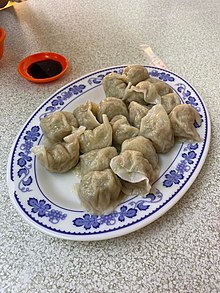
Back جياوزو Arabic Jiaozi Catalan Jiaozi German Jiaozi Spanish جیائوزی Persian Jiaozi French Iaosi Galician ג'יאוזי HE Csiaoce Hungarian Ցզյաոցզի Armenian
 A plate of boiled jiaozi with dipping sauce | |
| Type | Dumpling |
|---|---|
| Course | Entrée |
| Place of origin | China |
| Region or state | East Asia |
| Main ingredients | Dough, ground meat, or vegetables |
| Jiaozi | |||||||||||||||||||||||||||
|---|---|---|---|---|---|---|---|---|---|---|---|---|---|---|---|---|---|---|---|---|---|---|---|---|---|---|---|
| Chinese name | |||||||||||||||||||||||||||
| Traditional Chinese | 餃子 | ||||||||||||||||||||||||||
| Simplified Chinese | 饺子 | ||||||||||||||||||||||||||
| |||||||||||||||||||||||||||
| Manchu name | |||||||||||||||||||||||||||
| Manchu script | ᡤᡳᠶᠣᠰᡝ | ||||||||||||||||||||||||||
| Möllendorff | giyose | ||||||||||||||||||||||||||
Jiaozi (simplified Chinese: 饺子; traditional Chinese: 餃子; pinyin: jiǎo zi; [tɕjàʊ.tsɹ̩] ) are a type of Chinese dumpling. Jiaozi typically consist of a ground meat or vegetable filling wrapped into a thinly rolled piece of dough, which is then sealed by pressing the edges together. Finished jiaozi can be boiled (shuǐ jiǎo), steamed (zhēng jiǎo), pan-fried (jiān jiǎo), or deep-fried (zhá jiǎo), and are traditionally served with a black vinegar and sesame oil dip. They can also be served in a soup (tāng jiǎo).
Jiaozi have great cultural significance within China. Jiaozi are one of the major dishes eaten during the Chinese New Year throughout northern China and eaten all year round in the northern provinces. Their resemblance to the gold and silver ingots (sycee) used in Imperial China has meant that they symbolize wealth and good fortune.[1] Though considered part of Chinese cuisine, jiaozi are also popular in other parts of East Asia, where a Japanese variety is referred to as gyoza, and in the Western world, where a fried variety is referred to as potstickers. The term "potsticker" was introduced in Buwei Yang Chao's book How to Cook and Eat in Chinese (1949 revised enlarged edition).
- ^ "Extraordinary dumplings". BBC. Retrieved January 22, 2024.
© MMXXIII Rich X Search. We shall prevail. All rights reserved. Rich X Search